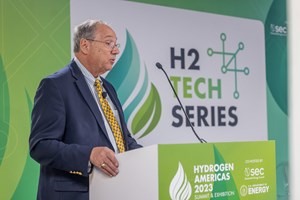News
An alternative carrier for H2: Utilizing methylcyclohexane for H2 transport
Story by: Tyler Campbell, Managing Editor
The Sustainable Energy Council (SEC) and the U.S. Department of Energy (DOE) hosted the second Hydrogen Americas Summit in Washington DC (United States). At the summit, the H2 Tech Series featured presentations on various hydrogen (H2) projects, equipment and services to progress the H2 economy. Robert Schneider, Senior Technical Advisor, Downstream and New Technologies for Chiyoda International Corp., delivered a presentation titled “Hydrogen value chain: LOHC–MCH for energy transition.”
Chiyoda is a global engineering company and has worked on various engineering, procurement and construction (EPC) contracts, including petrochemical and liquified natural gas (LNG) facilities. The company has since included battery storage and H2 projects. The presentation focused on the company’s commercially proven technology, SPERA (Latin for HOPE), used to transport H2 via the global supply chain.
In the process described, toluene—containing three double bonds—is hydrogenated to methylcyclohexane (MCH) using three hydrogen molecules. MCH is capable of being transported short and long distances and dehydrogenated back to toluene with three hydrogen molecules, making it a liquid organic H2 carrier (LOCH).
According to Schneider, SPERA transports MCH by whatever means is deemed most appropriate (e.g., tanker, rail line, pipeline) from the point of production to end use. The H2 is then recovered through dehydrogenation. Chiyoda then uses its proprietary catalyst, providing high conversion, selectivity and long-term stability; the toluene is transported back to the H2 production point and recycled, thus making it a circular carrier.
“Looking at the process from an overall perspective, we can consider the energy content of the H2 to be transported, hydrogenation conversion energy required, energy recovered from the hydrogenation exothermic reaction, energy used to transport the MCH and toluene and the energy required for dehydrogenation (an endothermic reaction),” Schneider said. “Considering these factors, we estimate an overall process efficiency of around 60%.”
When comparing LOHCs with ammonia (NH3) and liquid H2 (LH2), LOHCs can be transported at ambient temperatures, while NH3 and LH2 have more restrictions due to being cryogenic liquids. With MCH, H2 content is about 1/500 of the equivalent volume of gaseous H2, while the H2 contained volume in NH3 is 1/1300. MCH can also provide H2 at a purity above 99.8% (further cleaning will be required for it to reach fuel cell grade).
“In the case of NH3, H2 used as a fuel requires no further treatment, but for H2 recovery applications, NH3 cracking and subsequent purifications would be required,” Schneider said. “There is no question that NH3 cracking is possible; however, there are no large-scale NH3 cracking facilities in commercial operation.”
Schneider continued by showing a chart of the costs of producing H2 in South America and shipping it to the Port of Rotterdam in different forms—LH2, NH3, MCH, methanol and dibenzyltoluene (DBT). The chart shows that the shipping costs are not the primary issue and pale in comparison to H2 production, storage and other various supply chain costs.
To demonstrate the efficiency of SPERA, the company transported H2 from Brunei Darussalam to Japan (about 3,000 mi) in iso containers, where the H2 was recovered as a purified gas and used in a gas turbine electric power generator. Over the year of the demonstration, 210 metric t of H2 were successfully transported.


